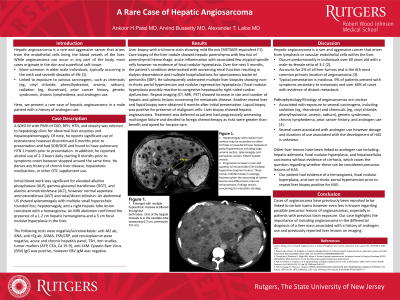Tuesday Poster Session
Category: Liver
P4695 - A Rare Case of Hepatic Angiosarcoma
Tuesday, October 29, 2024
10:30 AM - 4:00 PM ET
Location: Exhibit Hall E

Has Audio
- AP
Ankoor Patel, MD
Robert Wood Johnson Medical School, Rutgers University
New Brunswick, NJ
Presenting Author(s)
Ankoor Patel, MD, Arvind Bussetty, MD, Alexander Lalos, MD
Robert Wood Johnson Medical School, Rutgers University, New Brunswick, NJ
Introduction: Angiosarcomas are a rare and aggressive tumor of endothelial cell origin. Androgen use is noted to be a risk factor for the development of angiosarcomas. We report a rare case of hepatic angiosarcoma in a patient who initially presented with pHTN.
Case Description/Methods: A 60-year-old male with a history of CKD, BPH, HTN, obesity was referred to hepatology for abnormal liver enzymes and hepatosplenomegaly. Of note, patient reported SOB starting 8 months prior to presentation and was found to have findings consistent with pHTN on echocardiogram 1 month prior. He reports distant history of testosterone use and notable alcohol use of 2-3 beers daily for 8 months before symptoms began but stopped around the same time. He denies any history of chronic liver disease, hepatotoxic medications, or other OTC supplement use.
Initial blood work was significant for elevated ALP, GGT, and ALT, however normal AST and total/direct bilirubin. An abdominal US showed splenomegaly with multiple small hyperechoic rounded foci, hepatomegaly, and a right hepatic lobe lesion consistent with a hemangioma. An MRI abdomen confirmed the presence of a 1.2 cm hepatic hemangioma and a 5 cm FNH in the liver. Extensive work up for acute and chronic liver disease was negative. Tumor markers were negative. EBV IgG was positive, however EBV IgM was negative.
Liver biopsy with trichrome stain showed mild fibrosis (METAVIR F1). Core biopsy of the liver nodule showed no evidence of FNH and few foci of parenchymal hemorrhage with acute inflammation/microabscess formation containing few scattered atypical spindle cells. Over the next 5 months, the patient’s condition deteriorated with worsening renal function and multiple hospitalizations for SBP. He subsequently underwent multiple liver biopsies showing non-cirrhotic portal HTN and NRH/FNH possibly reactive to congestive hepatopathy from pHTN and right-sided cardiac dysfunction. Repeat imaging showed increase in size and number of hepatic and splenic lesions concerning for metastases. Repeat liver biopsy was performed 6 months after initial presentation. Liquid biopsy was positive for presence of malignant cells. Liver biopsy showed hepatic angiosarcoma. Treatment was deferred as patient had progressively worsening multiorgan failure and opted for hospice.
Discussion: We present a patient with prior distant history of androgen use who was eventually found to have hepatic angiosarcoma, despite initial negative malignancy workup on blood work and multiple liver biopsies.
Disclosures:
Ankoor Patel, MD, Arvind Bussetty, MD, Alexander Lalos, MD. P4695 - A Rare Case of Hepatic Angiosarcoma, ACG 2024 Annual Scientific Meeting Abstracts. Philadelphia, PA: American College of Gastroenterology.
Robert Wood Johnson Medical School, Rutgers University, New Brunswick, NJ
Introduction: Angiosarcomas are a rare and aggressive tumor of endothelial cell origin. Androgen use is noted to be a risk factor for the development of angiosarcomas. We report a rare case of hepatic angiosarcoma in a patient who initially presented with pHTN.
Case Description/Methods: A 60-year-old male with a history of CKD, BPH, HTN, obesity was referred to hepatology for abnormal liver enzymes and hepatosplenomegaly. Of note, patient reported SOB starting 8 months prior to presentation and was found to have findings consistent with pHTN on echocardiogram 1 month prior. He reports distant history of testosterone use and notable alcohol use of 2-3 beers daily for 8 months before symptoms began but stopped around the same time. He denies any history of chronic liver disease, hepatotoxic medications, or other OTC supplement use.
Initial blood work was significant for elevated ALP, GGT, and ALT, however normal AST and total/direct bilirubin. An abdominal US showed splenomegaly with multiple small hyperechoic rounded foci, hepatomegaly, and a right hepatic lobe lesion consistent with a hemangioma. An MRI abdomen confirmed the presence of a 1.2 cm hepatic hemangioma and a 5 cm FNH in the liver. Extensive work up for acute and chronic liver disease was negative. Tumor markers were negative. EBV IgG was positive, however EBV IgM was negative.
Liver biopsy with trichrome stain showed mild fibrosis (METAVIR F1). Core biopsy of the liver nodule showed no evidence of FNH and few foci of parenchymal hemorrhage with acute inflammation/microabscess formation containing few scattered atypical spindle cells. Over the next 5 months, the patient’s condition deteriorated with worsening renal function and multiple hospitalizations for SBP. He subsequently underwent multiple liver biopsies showing non-cirrhotic portal HTN and NRH/FNH possibly reactive to congestive hepatopathy from pHTN and right-sided cardiac dysfunction. Repeat imaging showed increase in size and number of hepatic and splenic lesions concerning for metastases. Repeat liver biopsy was performed 6 months after initial presentation. Liquid biopsy was positive for presence of malignant cells. Liver biopsy showed hepatic angiosarcoma. Treatment was deferred as patient had progressively worsening multiorgan failure and opted for hospice.
Discussion: We present a patient with prior distant history of androgen use who was eventually found to have hepatic angiosarcoma, despite initial negative malignancy workup on blood work and multiple liver biopsies.
Disclosures:
Ankoor Patel indicated no relevant financial relationships.
Arvind Bussetty indicated no relevant financial relationships.
Alexander Lalos indicated no relevant financial relationships.
Ankoor Patel, MD, Arvind Bussetty, MD, Alexander Lalos, MD. P4695 - A Rare Case of Hepatic Angiosarcoma, ACG 2024 Annual Scientific Meeting Abstracts. Philadelphia, PA: American College of Gastroenterology.

